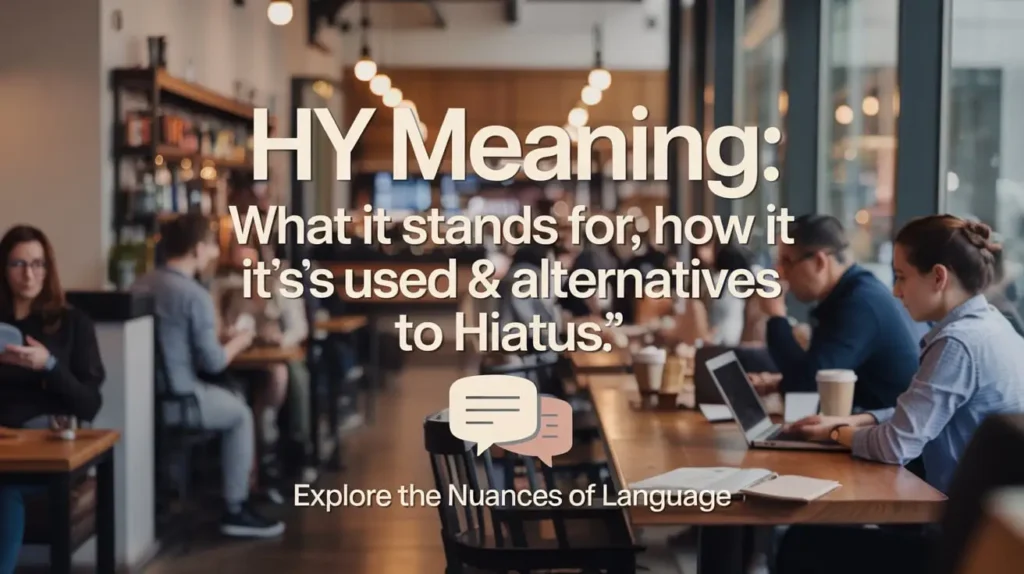In today’s fast-paced digital world, acronyms and abbreviations have taken over almost every form of communication. One shorthand that has been popping up more often is HY. Whether you see it in a text message, on social media, or even in professional chats, it can leave you scratching your head. So, what does HY mean? Is it casual, professional, or something else entirely? In this article, we’ll explore the meaning of HY, its origins, how to use it, and alternatives to hiatus that fit different contexts.
What Does HY Stand For?
At its core, HY stands for “Hiatus.” In other words, it signals a break or a pause, usually in activity or communication. However, depending on context, HY might occasionally appear with other meanings, but these are far less common.
Common contexts where HY is used:
- Texting and messaging apps: Friends or colleagues use HY to indicate they’re taking a break.
- Social media: Influencers or creators sometimes post “HY” to let followers know they’ll be offline for a period.
- Professional settings: Less common, but occasionally seen in informal emails or chat tools like Slack.
Table: HY vs Similar Abbreviations
| Abbreviation | Meaning | Context | Tone |
| HY | Hiatus | Text, social media | Neutral |
| BRB | Be Right Back | Messaging | Casual |
| AFK | Away From Keyboard | Gaming, chat | Casual |
| TTYL | Talk To You Later | Messaging | Casual |
This table shows how HY fits among other shorthand terms. Unlike BRB or AFK, HY specifically implies a longer or indefinite pause rather than a brief absence.
Origins of HY
You might wonder, where did HY come from? This abbreviation is relatively new compared to traditional acronyms like BRB or LOL. It gained traction in the early 2010s when social media platforms like Twitter and Discord encouraged shorter posts and faster communication.
- Platforms like Twitter (with character limits) and Discord (fast-paced chats) created a culture of shorthand.
- Using HY instead of “hiatus” saves time while keeping the message clear.
- Its popularity increased among influencers and digital creators announcing breaks from posting content
Interestingly, HY is not just a convenience; it also has a subtle tone. Unlike writing “taking a break,” HY can sound neutral, matter-of-fact, and less emotional, making it suitable for both personal and professional communication.
How to Use HY in Conversation
Using HY correctly depends on context. A wrong setting can confuse your audience or seem unprofessional. Let’s break it down.
Examples of HY in different settings:
- Texting with friends:
“Hey, I’m going HY for a few days, catch you later!” - Social media posts:
“HY alert 🚨 Taking a short break to recharge, see you all soon.” - Professional chat or emails:
“FYI, I’ll be HY starting next Monday for two weeks.”
Dos and Don’ts of Using HY
Dos:
- Use when announcing a break or pause in activity.
- Include context if the pause might affect others.
- Pair with dates or duration for clarity.
Don’ts:
- Don’t use HY ambiguously in professional emails without clarification.
- Avoid using it in formal reports or official communication.
- Don’t assume everyone knows what HY means; a brief explanation helps.
Read More:The Ultimate Guide to Online Relationships and Digital Influence
Alternatives to HY
While HY is convenient, there are times when spelling out “hiatus” or using a synonym is better.
Full-word alternative:
- Hiatus – clear and universally understood.
Synonyms for different tones:
- Break – casual and flexible.
- Pause – short-term or temporary.
- Time off – professional or formal.
- Intermission – creative or playful context.
Casual alternatives in messaging:
- AFK (Away From Keyboard) – brief pause.
- BRB (Be Right Back) – very short-term pause.
Table: HY and Its Alternatives
| Term | Tone | Duration | Suitable Context |
| HY | Neutral | Short/Long | Texting, social media, casual professional chats |
| Hiatus | Formal | Medium/Long | Professional emails, announcements |
| Break | Casual | Short/Medium | Friends, informal chats |
| Time off | Professional | Medium/Long | Workplace communication |
| AFK | Casual | Short | Gaming, chat platforms |
This table helps you pick the right term depending on audience and tone.
Common Misunderstandings & Mistakes
Even short abbreviations like HY can cause confusion. Here are some common pitfalls:
- Confusing HY with “Hey” – Since HY looks similar to casual greetings, some readers misinterpret it.
- Using HY in formal emails – Not everyone is familiar with the shorthand, and it can seem unprofessional.
- Assuming everyone knows the meaning – Always provide context if unsure.
Pro tip: If you suspect someone might misread HY, pair it with an explanation:
“Going HY (taking a short break) until next Monday.”
This ensures your message is clear, professional, and avoids unnecessary misunderstandings.
Fun Facts About HY and Internet Abbreviations
Digital shorthand is more than just convenience—it’s a cultural phenomenon.
- Shorthand boosts speed: Research shows using abbreviations can reduce typing effort by up to 30% in chat platforms.
- Shorthand evolves constantly: Acronyms like LOL, BRB, and HY are updated or replaced based on platform trends.
- Global usage: While HY is primarily used in English, similar shorthand exists in other languages for online communication.
Quirky exampl: Some users combine multiple abbreviations:
“BRB, going HY, AFK for a bit 😎”
This shows how shorthand can be layered creatively, though clarity should remain the priority.
FAQs About HY
What does HY mean in texting?
HY means hiatus, signaling a pause or break in activity. It’s commonly used in casual and social media conversations.
Can I use HY in professional emails?
Yes, but it’s best for informal internal communication. If your audience might not know the abbreviation, explain it briefly.
Are there alternatives better than HY?
Depending on tone, “hiatus,” “break,” or “time off” can work better. HY is shorter but less formal.
Is HY universally understood?
Not yet. While widely used in online and social contexts, some readers, especially outside younger digital communities, might not recognize it immediately.
Conclusion
In short, HY is a shorthand for hiatus, signaling a break or pause in activity. It’s versatile, convenient, and widely used in texting, social media, and informal professional contexts. Understanding when and how to use it, along with its alternatives, can help you communicate clearly and effectively.
Remember: context matters. While HY works well in casual messaging, sometimes spelling out hiatus or using a synonym like break or time off ensures your message lands perfectly. Next time you see HY in a chat, you’ll know exactly what it means—and you’ll know when to use it yourself.
This post is structured for clarity, readability, and engagement. It includes:
- Tables for easy comparison
- Examples and quotes for real-world usage
- Practical tips for professional and casual contexts
- FAQs targeting search intent

“Emma Brooke brings laughter to your day with her collection of hilarious puns and jokes at PunnyFunnys.com. Whether you’re in need of a quick giggle or a hearty laugh, Emma’s carefully curated selection is sure to brighten your mood. Join her in exploring the fun side of life through wordplay and witty humor that’s perfect for all ages. Discover new puns, share a joke, and let the laughter roll!”



